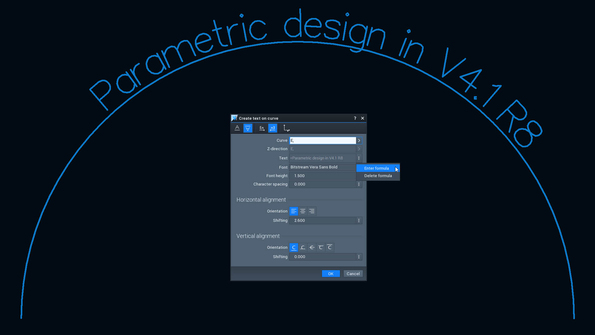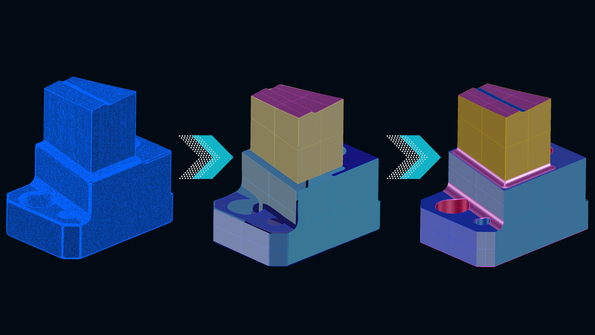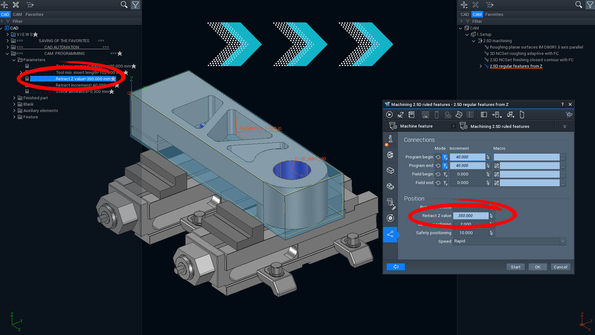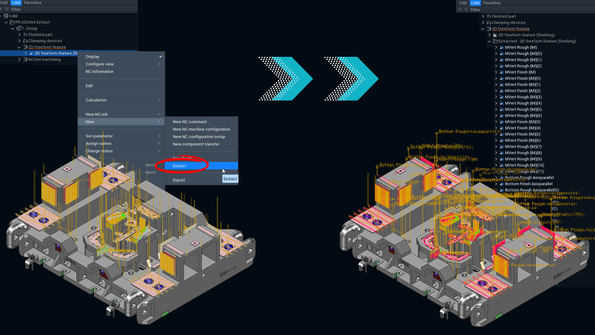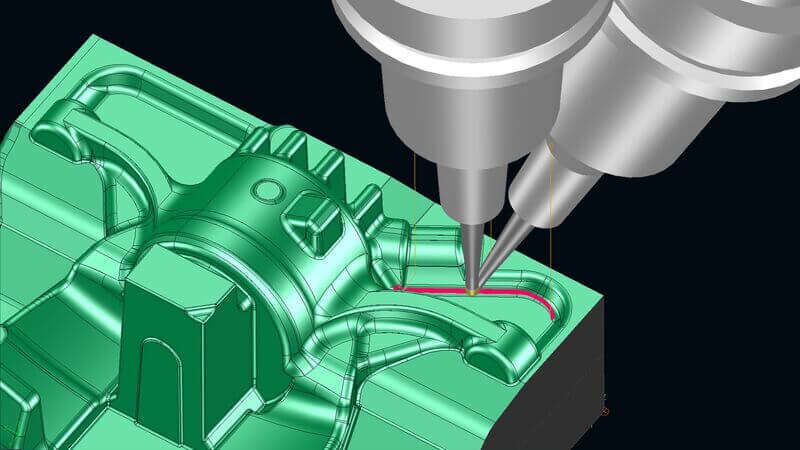-
Software
-
CAM software
- Tebis Automill
- CNC programming
- CNC automation
- CNC simulator
- Multiple setup
- Robotic machining
- CNC drilling
- Deep-hole drilling
- Combined turn-milling
- CNC turning
- Turn-milling
- 2.5D milling
- 3D milling
- 5-axis milling
- Slot milling
- Trimming
- HPC milling
- HFC milling
- Circle-segment cutters
- Sinker EDM
- Wire EDM
- 3D laser cutting
- Laser hardening
- Laser weld cladding
- CAD software
- CAQ software
- MES software
- Products
-
CAM software
- Services
- Consulting
- Sectors
- References
- Company
- News

-

Tebis 4.1 Release 8 – Flexibility meets automation
Tebis gives you maximum automation flexibility. Release 8 is no exception: Many new features and extensions offer more automation for design, data preparation and CAM programming. For example, CAM programming can be adapted to specific manufacturing situations.
A special feature of this is interpolation turning, which can quickly, easily and efficiently manufacture rotationally symmetrical areas on many milling machines at a low cost. This modern manufacturing method creates new opportunities for you to extend your portfolio and meet more of your customers’ requirements. Tebis is also the only CAD/CAM system on the market with 6-axis simultaneous interpolation turning in its portfolio: This enables even faster manufacturing of undercut areas with outstanding surface quality.
Your benefits at a glance:
- More automation in design and data preparation: Create and link parametric character strings
- Automatically generate surfaces in reverse engineering: Create high-precision approximation surfaces faster
- Combine CAD and CAM better than ever: Automatically link CAD and CAM parameters
- Experience highly automated, yet flexible programming: Extract and modify individual NCJobs
- Multi-axis simultaneous milling: Precisely control machine axes and tool direction for better surfaces and shorter machine run time
- Easily create complex NC programs: Automatic avoidance in the Z direction
- Indexed collision avoidance: Optimized residual stock machining
- Top performance: Faster calculation of residual stock machining
- Faster machining when roughing: Increase individual tool feed
- Complete support for interpolation turning: For machining on milling machines, including 6-axis simultaneous interpolation turning for outstanding surface quality
CAD – 3D design
Create and link parametric character strings
In addition, text parameters can now be created, edited and configured using formulas for any character string. They can be linked with text, bore and pocket functions, in variant tables and controlled with strings.
For example, the part can be labeled based on the dimensions of the part envelope.
Your benefit:
- Time savings due to greater automation
- Simpler data preparation
CAD – Reverse engineering
Automatically generate surfaces on meshes
Automatically generate approximation surfaces (center) on mesh data (left) and create parametric CAD models (right).Planar and free-form surfaces can now be automatically calculated on meshes without having to design an area on the reference geometry.
The result is high-precision approximation surfaces that can be linked together and edited parametrically for subsequent processes. The surfaces can also be automatically aligned, which results in geometries that are ready for manufacturing at the click of a button.
Your benefit:
- Generate high-precision approximation surfaces faster
- For example, more easily and automatically prepare dies, structural elements, trim and coining steels
CAM – Automation
Control CAM programming with CAD parameters
Tebis takes the next step towards combined CAD/CAM technology by enabling targeted control of CAM programming via CAD parameters: CAD object parameters can now be directly linked to CAM parameters. They can be numerically defined geometric properties, such as length and height. Many of our customers define specific formula-based "control parameters," which simplifies design and data preparation. In Release 8, these results can be directly transferred to the CAM world.
Here are two simple examples of combined technology: The electrode spark gap corresponds to the negative milling element stock allowance or wall thickness; the sum of the part’s height and safety clearance provides the Z retract distance.
You still retain maximum flexibility. Because Tebis parametric design is specifically intended for fast and efficient manufacturing processes, you can decide for yourself whether a change in a CAD parameter should be passed on to CAM programming: For example, a larger blank or a smaller area shouldn’t necessarily mean that the NCJob needs to be reset.
Your benefit:
- Faster CAM programming
- Simplified template technology with CAD and CAM
Maximum flexibility in programming with machining sequences and free-form features
Automation jobs for machining 2.5D free-form features and 2.5D or 3D machining sequences (i.e., NCSets) can now be broken down into individual NCJobs. Quickly and easily modify NCJobs after the fact, add new jobs or change the machining sequence – regardless of whether the NCJob has already been calculated.
Your benefit:
- Respond quickly and ensure process reliability from the programming office when there’s a change in the work situation in the machine pool
CAM – Milling
Multi-axis simultaneous milling: Precisely control machine axes
The movements of the pivot and rotation axes can now be specifically controlled for multi-axis simultaneous milling with no additional design work. For example, an axis can be completely clamped and the movement of the second axis can be interpolated between two angles. Interpolation is possible in the milling and path directions.
Your benefit:
- Maximum flexibility
- Appropriate for all tool types and machine kinematics
- Homogeneous machine movements, resulting in higher surface quality
- Simplified simultaneous 5-axis programming with an interactive dialog
- No additional module required
Multi-axis simultaneous milling: Targeted control of the tool direction
View video / contact formPlease select the Preference cookies to activate the display.Activate cookiesSimultaneous machining with or without clamping.You can now control the tool direction when using plumb elements in 5-axis simultaneous surface finishing.
Three modes are available for this process: The "Rigid in milling direction" option interpolates between the stepover direction and the plumb element. The tool direction remains constant in the milling direction. The "Rigid in stepover direction" option interpolates between the milling direction and the plumb element. In this case, the tool direction remains constant in the stepover direction. As an alternative, it’s possible to interpolate in both directions using the "None" option.
Your benefit:
- Homogeneous machine movements
- Faster machining
2.5D contour machining: Automatically avoid collisions in Z direction
View video / contact formPlease select the Preference cookies to activate the display.Activate cookiesAutomatically avoid collisions in Z direction.The milling paths can now be automatically shifted in the axial direction to avoid potential collisions in 2.5D contour machining by using the "Axial avoidance" option.
The maximum tool insert length is therefore optimally deployed: As much material as possible is removed in a single cut, with no retracts.
You still remain flexible: You can determine if the tool holder should be accounted for in the collision analysis and define different stock allowances for the shank, holder and machine head as needed.
Your benefit:
- Easily, flexibly and safely create complex NC programs
- Avoid unnecessary time-consuming retract movements
- High dimensional accuracy
- Low tool wear
Indexed collision avoidance: Optimized residual stock machining of fillets and cavities
Indexed collision avoidance for combined residual stock machining can now be achieved during calculation. You can select either "Automatic" and "Manual" mode: In "Automatic" mode, the areas that can be machined with a fixed tool direction are automatically determined. In "Manual" mode, you can interactively define the corresponding areas.
In addition, you can now perform overlapping machining of areas in all collision avoidance strategies. The result is high-quality surfaces with no steps.
Your benefit:
- User-friendly and flexible CAM programming
- Higher surface quality
Even faster calculation of residual stock machining
View video / contact formPlease select the Preference cookies to activate the display.Activate cookiesCalculation comparison: Tebis 4.1 Release 7 - Release 8.Performance of Tebis CAD/CAM software has been further improved: NCJobs are calculated more than 60% faster for residual stock machining, using the "Fillet parallel" strategy.
Your benefit:
- Faster completion of the NC program
Faster machining when roughing
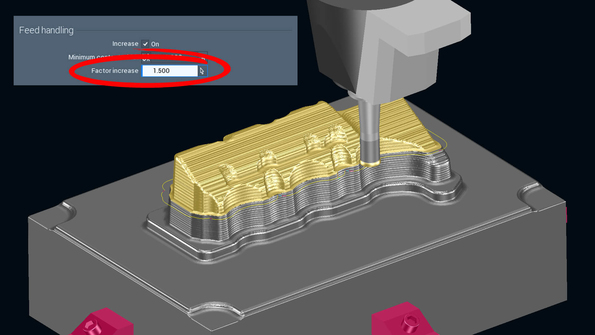 Traverse sections at higher feed rates.
Traverse sections at higher feed rates.Individual tool feed adjustment is now possible when roughing surfaces. This enables tool movement at higher feed rates in sections along the milling path, depending on the extent of tool contact and material removal.
Your benefit:
- Shorter machine run time
CAM – Turning
In addition to turn-milling and mill-turning, Tebis now supports interpolation turning, including the unique feature of 6-axis simultaneous interpolation turning.
Interpolation turning permits turning operations on all machines with a position-controlled spindle, including milling machines. This method is especially appropriate for parts with several milled elements and fewer turned elements. The part holder remains rigid. The cutting movement is a spiral in the X, Y and Z directions around the rotation axis of the part geometry.
Interpolation turning delivers time savings of 80%. For example, areas that previously had to be milled can now be turned.
6-axis simultaneous interpolation turning is ideal for easily and efficiently producing undercut milling element areas in a single setup. These areas can be machined using very short tools and the spindle interpolates smoothly, resulting in better surface quality: the ideal technology when precision is paramount.
Your benefit:
- Suitable for many machine types and part geometries
- Suitable even for milling machines that don’t have a directly driven rotary table.
- Also suitable for manufacturing geometry elements, such as gaskets and connections on turn-milling machines. Machining is tilted from the turning center,
- including off-center turning for manufacturing eccentric turned parts.
- Cost-effective: Simple turning tools can produce
- optimal surfaces, with no reworking required

